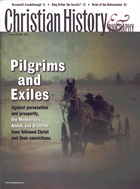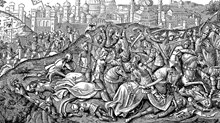STARTING YEARS FOR VARIOUS DENOMINATIONS
1693 AMISH
1693 MENNONITES
1708 GERMAN BAPTIST BRETHREN
1780 RIVER BRETHREN
1860 OLD ORDER AMISH
1860 AMISH MENNONITES
1862 BRETHREN IN CHRIST
1872 OLD ORDER MENNONITES
1881 OLD GERMAN BRETHREN
1883 BRETHREN CHURCH
1907 OLD ORDER AUTOMOBILE
1907 OLD ORDER HORSE
1926 DUNKARD BRETHREN
1927 BEACHYAMISH
1939 GRACE BRETHREN
1960 NEW ORDER AMISH
OLD WORLD ORIGINS
1525 Conrad Grebel rebaptizes George Blaurock as the first convert to Anabaptism
1527 Swiss leaders draw up the Schleitheim Confession, identifying seven distinctives of Anabaptist belief
1529 Melchior Hoffman joins Anabaptists and proclaims Strasbourg the "New Jerusalem"
1535 A second 'New Jerusalem —Münster— fails miserably, sparking widespread persecution of Anabaptists
1536 Menno Simons leaves the Catholic Church to become the Anabaptists' foremost theologian
1618-1648 Thirty Years' War rages
1632 The Dordrecht Confession unites Mennonites around 18 articles of faith
1660Tieleman Jansz van Braght compiles the Martyrs Mirror
1675 Philip Jacob Spener pens his Plo Desideria, giving new impetus to the Pietist movement
NEW WORLD ORIGINS:
AMERICAN SETTLEMENT
1683 Mennonites and Quakers establish Germantown just north of Philadelphia at William Penn's invitation
1693 Jakob Ammann breaks fellowship with Swiss Anabaptists over church discipline
1698 Mennonites appoint William Rittenhouse to pastor the first Anabaptist congregation in America
1708 Alexander and Anna Margareta Mack and others gather at the Eder River in Germany for baptism, birthing the Brethren movement
1719 The first group of Brethren arrive in America aboard the ship Allen
1732 Georg Conrad Beissel breaks off from the Brethren to establish the Ephrata Cloister
1749 Jacob Hertzler becomes the first Amish bishop to arrive in America
1775 American Anabaptists meet with revolutionary authorities to offer humanitarian aid rather than fight the British
MODERNITY:
ASSIMILATION AND REACTION
1860s Amish Mennonites split from Old Order; Amish over their determination to blend better with English' society
1872 Old Order Mennonites reject changes brought about by contact with revivalism
1881-1882 The Brethren split over revivalistic methods into Old Order German Baptist Brethren, conservative, and progressive factions
1907 Old Order Mennonites split over adoption of the automobile
1927 Moses M. Beachy refuses to shun those Amish who joined the Mennonite church, and thus parts from the Old Order Amish
1946 Mennonite Mutual Aid is organized to help young men returning from Civilian Public Service camps
1967 The National Amish Steering Committee forms to resolve disputes with the government over issues of nonconformity
1972 In Wisconsin v. Yoder, the U.S. Supreme Court permits Amish youth to end their education in Amish-run schools after eight grades
Copyright © 2004 by the author or Christianity Today/Christian History magazine.
Click here for reprint information on Christian History.

Support Our Work
Subscribe to CT for less than $4.25/month




























